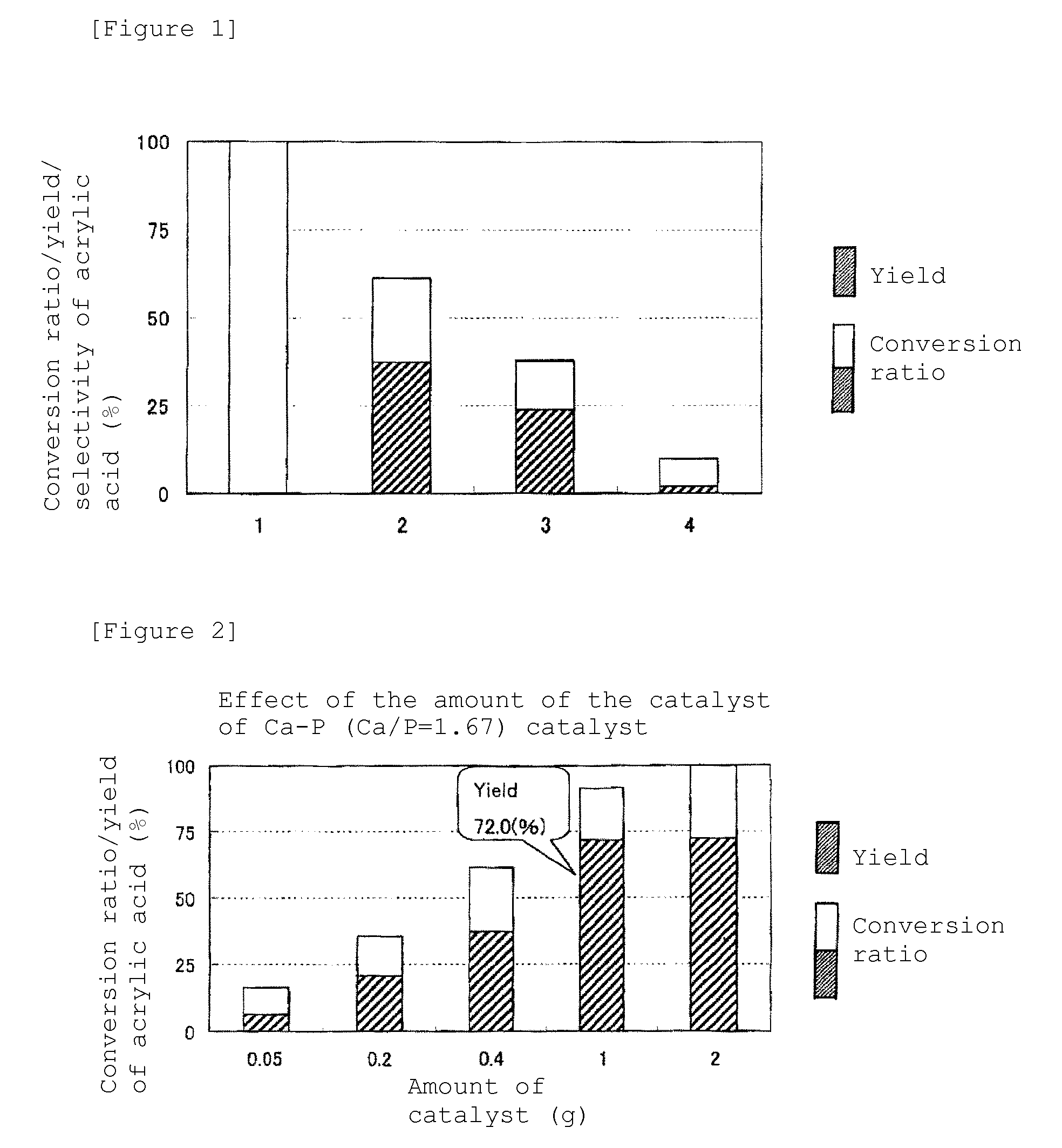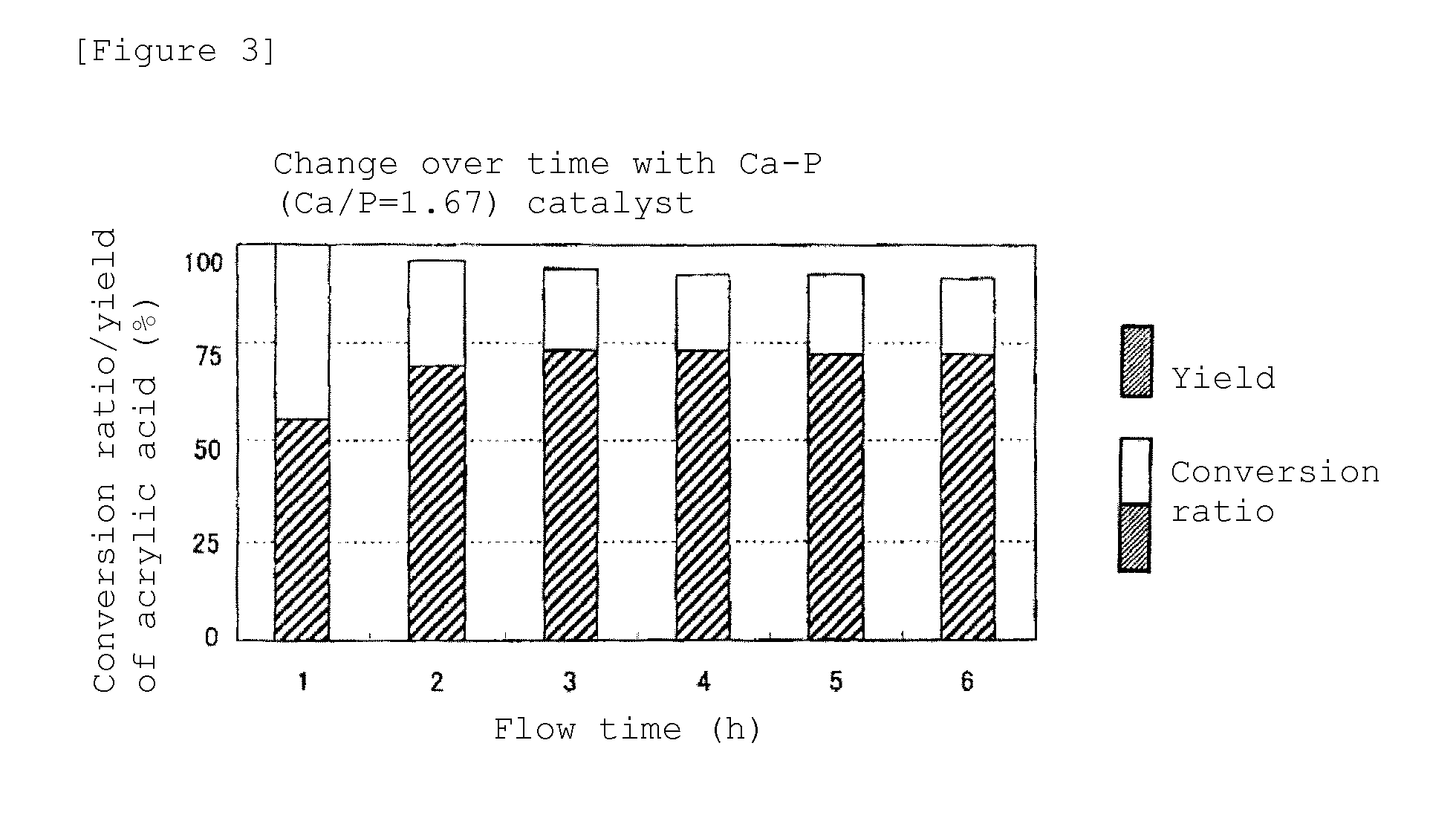Method for Synthesizing Unsaturated Carboxylic Acid and/or Derivative of Same
- Summary
- Abstract
- Description
- Claims
- Application Information
AI Technical Summary
Benefits of technology
Problems solved by technology
Method used
Image
Examples
experimental example 1
Effect of the Type of Catalyst
[Preparation of Apatite Compound]
[0027]1 mmol of P2O5 was dissolved in 7 ml of an aqueous solution comprising 7 mmol of NaOH, followed by addition of 8 ml of an aqueous solution comprising 3.33 mmol of calcium nitrate or strontium nitrate, to give two types of suspension. This suspension was introduced into an autoclave lined with polytetrafluoroethylene, and a hydrothermal treatment was performed at 110° C. and at a pressure of 143 kPa for 14 hours, while stirring. After the hydrothermal treatment, the obtained precipitates were well washed with water, and dried at 60° C. for 5 hours. M10(M′O4)6(OH)2 (M is Ca or Sr, and M′ is P) in a powder state was obtained. This powder was shaped into pellets, which were then ground into a product having a size of approximately 250 to 500 μm, and the product thus obtained was used as a catalyst.
[Preparation of Catalyst Using Silica Gel]
[0028]1 mmol (based on P) of P2O5, or 1 mmol (based on Ca) of CaNO3 was thoroughl...
experimental example 2
Effect of Ca / P
[0042]Next, an experiment of changing Ca / P in the apatite compound was performed, and the effect was investigated. The use ratio of Ca source and P source in the hydrothermal reaction of experimental example 1 was changed, to synthesize catalysts with Ca / P of 1.5, 1.6, and 1.8.
[0043]A synthesis reaction of acrylic acid was performed for 6 hours, in a similar manner to experimental example 1, except that the amount of the catalyst used was 1 g. The Ca10(PO4)6(OH)2 with Ca / P of 1.67 showed the highest result, in which the conversion ratio of lactic acid was 91.4% and the yield of acrylic acid was 72.0%. Also, in all the cases of Ca / P of 1.5, 1.6, and 1.8, the yield of acrylic acid was over 50%, and it was enough for a catalytic performance. In addition, a similar experiment was performed for Sr10(PO4)6(OH)2, with the amount of the catalyst of 1 g, and it could be confirmed that the conversion ratio was 54.3% and the yield of acrylic acid was 33.6%.
experimental example 3
Effect of Amount of Catalyst
[0044]Using Ca10(PO4)6(OH)2 with Ca / P of 1.67, the amount of the catalyst was changed to investigate its effect. A synthesis reaction of acrylic acid was performed for 6 hours, in a similar manner to experimental example 1, except for changing the amount of the catalyst used. The results are shown in FIG. 2. Both the conversion ratio of lactic acid and the yield of acrylic acid increased along with increase in the amount of the catalyst up to 1 g. When the amount of the catalyst was set to 2 g, the conversion ratio of lactic acid was 100%, but the yield of acrylic acid was very little changed from that of the case of 1 g, and thus the effectiveness of catalyst reached the limit.
PUM
| Property | Measurement | Unit |
|---|---|---|
| Molar ratio | aaaaa | aaaaa |
Abstract
Description
Claims
Application Information
 Login to View More
Login to View More - R&D
- Intellectual Property
- Life Sciences
- Materials
- Tech Scout
- Unparalleled Data Quality
- Higher Quality Content
- 60% Fewer Hallucinations
Browse by: Latest US Patents, China's latest patents, Technical Efficacy Thesaurus, Application Domain, Technology Topic, Popular Technical Reports.
© 2025 PatSnap. All rights reserved.Legal|Privacy policy|Modern Slavery Act Transparency Statement|Sitemap|About US| Contact US: help@patsnap.com


